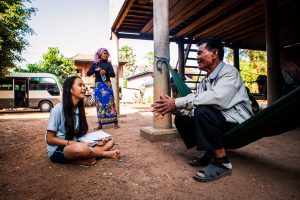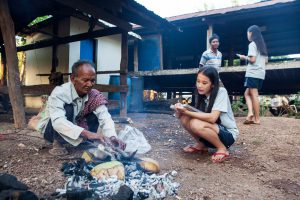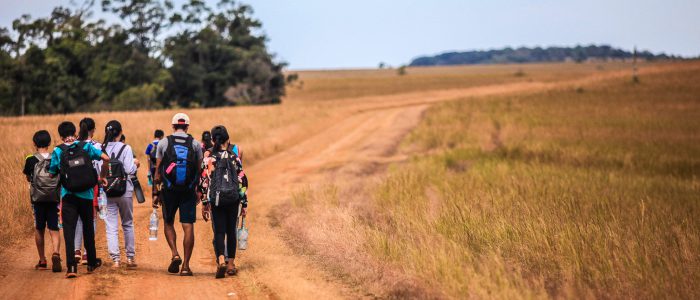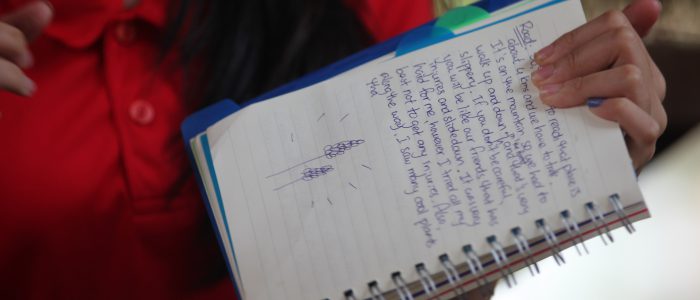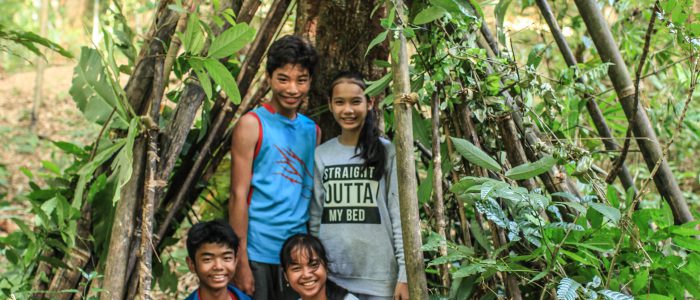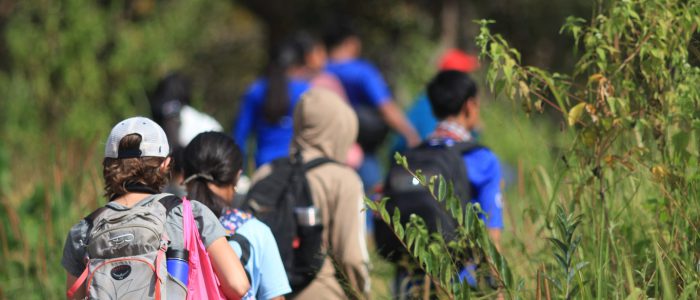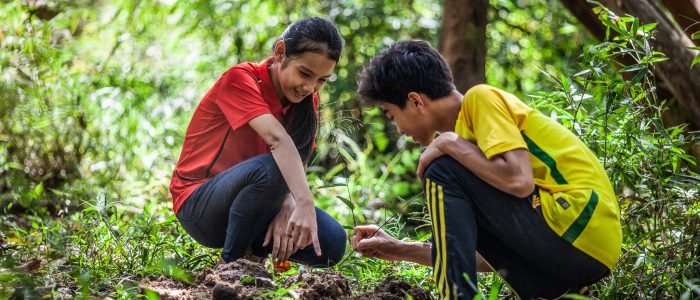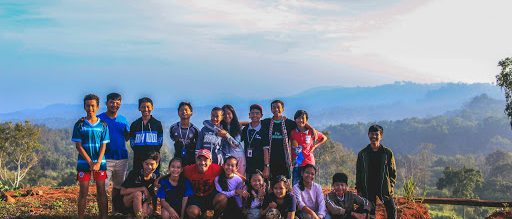Ecotourism Exploration
Community Based Ecotourism exploration have been happening for two rounds already and I’ve involved in this exploration in the second round. In this exploration, we studied about what CBET is and the goal is to develop a CBET site in Kui Indigenous community in Bankernphal Village, Romtom Commune, Rovieng District, Preah Vihear Province. Actually, this idea comes from Indigenous exploration that studied about Kui indigenous community since the round before that.
In the first round of this exploration, we were more focused on the market survey which we went out to different places in Phnom Penh to survey visitors, mostly foreigners, whether they would want to visit our sites or not. So far, we have surveyed 255 tourists and the results that we got is 97% of them would want to visit our place if it happen. For the second round, we focused on feasibility study whether the place is feasible to be developed as a community based ecotourism. To study this, we took a 5 days and 4 nights trip to the community and we mostly camped in the forest since we needed to assess several places in the forest. After assessing all of the places, the result that we got is the place is feasible to be developed as a CBET.
As a conclusion, learning and exploring about Community Based Ecotourism was splendid and I got to spend time in nature more than other explorations and I can say it’s an amazing adventure. In addition, this exploration play a role in providing a positive impact on the community such as conserving forest and wildlife and providing income to the community so that they would have a higher living standard. Not only this, it will influence over 800 people.
STEMgineering Exploration – Round 4
What is this Exploration?
STEMgineering is an exploration that studied about engineering, type of engineering and creating STEM project for government students to become interested and excited in STEM because the government school’s curriculum doesn’t include this subject. And the main goal of this exploration. As we come up with the STEM project ideas that all children all over Cambodia can use, we had to think that the projects have to be sustainable and Cambodia-friendly.
What have we learned about engineer in this exploration?
Before starting this STEM project ideas, we got introduced to engineer, type of engineer and what they do. We started with all of the six simple machines such as wheel and axle, lever, pulley, inclined plane, wedge and screw. To learn about this, we divided into group and research one type of the machine, then we’ll share with our classmate through presentation. We also get to do an activity about this which finding the material with these simple machines in campus and watch many videos related to the topic to understand more about it. After that, we had learned about the Design process which is the series of step that engineer follow to come up with a solution to the problem. After learning and following all these steps, our projects is really effective.
Our STEM project!
Then, we started brainstorming ideas of the projects that we wanna create for the government school. And what i’ve learned about brainstorming ideas is that it’s all about “quantity, not quality”. We we successfully creating and prototyping our projects, we went to two different government schools to showcase our project. The challenge that we face is that it’s hard to get those students engage with our project. However, as we had this experience, we tried to play games with them first to get to know more about each other in our second trip and that was successful. The students learned a lot and they were so excited in STEM. This make me felt so happy and proud and teaching, explaining other people is my favorite thing to do. Overall, i’ve learned much about engineering in this exploration and this was my first engineering class ever.
Indigenous Community Exploration-Round 3
Indigenous Community is an exploration that studies about some indigenous communities in Cambodia. Specifically, we had learned two indigenous communities which are “Kui” ( Preah Vihear ) and “Stieng” ( Kratie ). In these two communities, We learned about their culture, daily life, the people, their beliefs, education, the ceremonies in their community and more. The goal of this exploration is to promote and preserve their people and cultures to Cambodian as well as to the world. Not only this, but this exploration is also want us to improve interviewing skills, writing skills, designing skill, as well as video skill. By the end of this exploration, we aimed to have two products finished which are a book for Kui indigenous community and a video for Stieng community. So, we divided into two groups also, some students work on a book of Kui community and some students work on a video of Stieng community.
In order to have these products finished, we had a trip to Kratie and Preah Vihear provinces for 2 nights and three days to do research and seeking for the information. After the trip, we collected all of the information to put into the book and the video. For the students that responsible for the video, they started work on the video, editing, and include the subtitle into the video. For the students that responsible for the book, we started writing in English and Khmer and input it into software for designing a book which is Adobe Indesign. As you know that our exploration has only seven weeks and we had only 2 or 3 weeks left to create this book before Sharation so that we had to rush and what I am really proud to myself and other teammate is that it took us only 1 day to complete the whole book. Moreover, to improve the quality of the book we took another trip to Preah Vihear province for a night to verify the information with the people there.
Finally, By having this exploration I’ve learned about Kui and Stieng Indigenous a lot, including the people, they are very kind and I think I had impacted their community by creating these two products for them.
Outdoor Leadership- Exploration
Outdoor leadership exploration is a learning project based on how to survive and lead yourself and others in the outdoor such as finding food, live without shower, uses natural bathroom and how can you rescue people in the emergency . When we started this exploration, we’ve discussed about Nature, What is Nature? And what does nature mean to us personally? After I have discussed about this I understood that there’s no right or wrong answer of what nature really mean and nature doesn’t have only one meaning, there are many different meanings of nature from the different people perspective. Also, I haven’t noticed or observe much about nature or even don’t know its real definition but I knew more and understand deeper than it really meaningful to me and now I can give my own meaning for it.
In addition, we learned about Risk Management and risk management and assessment. In order to manage the risks, we have to do 4 steps such as identify the risk, assess the risk, control the risk and review or reflect the risk. Also, rescuing people in emergency such as way to keep them alive, checking for heartbeat, blowing air into the patient mouth and especially doing the chess compression. After learning all of these basic lessons, We took two trips, one is small trip and one more is big trip. For the small trip, we had an overnight trip to Kirirom national park in Kampong Speu. Along the way, at the national park, I noticed that there are many pine trees, which are so straight and they grow in a pattern which look beautiful. We also met a woman riding her motorbike with a lot of stuff such as rice, fish, ices and she couldn’t handle it because it’s too much, so some of us get off the bus to help her and she seem very happy. When we arrived, we walk to the waterfall for 6km and I was tired and carried a heavy backpack which hurt my shoulder but I tried so hard and made it to the waterfall because of the nice view along the way which motivated to continue walking. We camp at the Srah Srang lake where there are nice scenery and weather with all nature surrounded. There are some gazebos along the lake and it’s a relaxing place. When it’s time to cook, we had a problem with the stove which is not working, however we find an alternative way which is creating fire, some of us was trying to find more sticks and some was making fire, so we collaborate with each other so well and luckily we found an old stove under the gazebo near our camp place so we used it as our stove and this is also a good lesson for me and others too because if we don’t have something, we can always use things surround us and especially nature.
For the big trip, we went to Mondulkiri for four days and 3 nights . We did a lot of activities such as trying to create fire without using the lighter, cook food by ourselves, did many hiking to different places like waterfall, practice rescue people when there is emergency and making campfire at night.
Here are some of highlights from the trips:
Trekking Route: One of the trekking route to the waterfall is about 4 km and it’s on the mountain, so we had to walk up and down in the forest and that’s was very slippery. If you don’t be careful , you will be like our friends that has injuries and slide down. It was very hard for me , however i tried all my best not to get any injuries. Also, along the way there are many cool plants that had caught my attention.
Got to see an Elephant: I was very excited to see an elephant at the waterfall and it’s the only elephant that is left because others were died. I’ve seen elephants many times already, but this was my first time touching it and took photo with it and I was very happy while staying with it.
Geography Exploration- Round 1
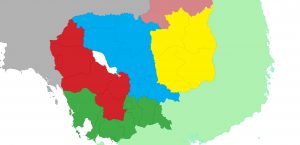
Since the last two rounds, We have a project which is creating the geography book of Cambodia. We’ve been working so hard on this book for two years already, including the researching, trips, content, and designing. And this is my third round of designing this book and right now we are on the last stage to get it done and will be published soon. In fact, our dateline supposed to be last year, however, we think that it’s too much text and it’s not attractive for the readers, so we decided to expand the dateline until this ear and working on putting more graphic designs instead of many texts. For this round, we still continue designing the layout for each province, working on graphic designs and also did some content checking again. We use the Adobe Indesign software to create our book. Beside this, we also use more software to create graphic designs such as Photoshop, Illustrator, and Lightroom to edit the pictures. All of the pictures that we put in the book are originally taken by our students. I’ve never known all of these websites before, so I tried to learn on my own, ask my friends or seniors who had used them and learn more from
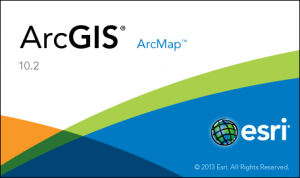
internet and youtube. We also took a 3 months courses on learning about the Arc.GIS software which is software for creating maps because we created our own maps to put in the book. When we finished designing and making graphic designs, we have to check the
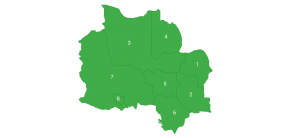
the book consistency to make sure that it’s consistent with the font, font size, dash, footnote, color tabs and more. After learning this exploration, my knowledge had expanded a lot about the geography of Cambodia and many other software, especially Indesign. Sometimes we had many challenges and feel stressed but I had overcomes those problems by imagining how amazing of young Cambodian children publishing an enormous geography book by themselves and how glad would Cambodian students be by having an incredible source for part of their learning.

